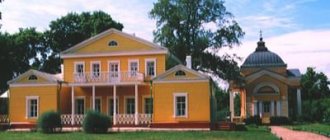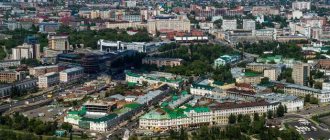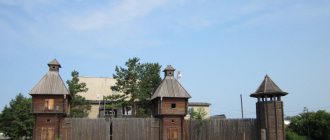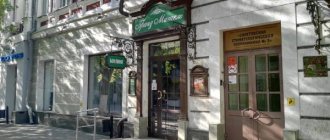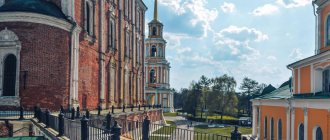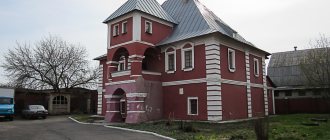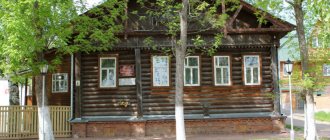Omsk was founded as a border fortress in 1716, a city on the banks of the Om River, which over the three centuries of its existence has turned into a large cultural
the center of a huge region, a city of over a million. Numerous iconic places - the most interesting sights of Omsk are able to impress the most sophisticated tourists and guests of the “Third Capital of Siberia”.
A sightseeing tour of Omsk must include an overview of the top main attractions of Omsk - both historical and monuments completely restored from photographs. A guided tour is possible either on foot or by bus.
Omsk fortress
The fortress in Omsk was part of an outpost guard line that protected Siberian silver smelters. It was erected in the 18th century by order of Catherine II. Only isolated fragments of the Omsk fortress have survived to this day: a guardhouse (the oldest stone building in the city), a church, an arsenal, a commandant's house, a barn, a dining room with a kitchen for a reserve battalion, and a disciplinary barracks.
Four gates led to the territory of the fortress: Omsk, Tarsk, Tobolsk and Irtysh. Tobolsk is the only gate that has survived to this day. The rest had to be restored. One of the striking attractions of the historical complex is the house in which the commandant of the fortress once lived. Now the Dostoevsky Museum is located there; the great writer spent four years in the local prison.
Spasskaya Church in Tara
The Spasskaya Church in the village of Tara is the oldest stone building in the Omsk region and a unique, one-of-a-kind beautiful monument in the Siberian Baroque style with the inclusion of original elements.
A beautiful temple was built in 1753-1776. by Tobolsk masters in the manner of those times - a diagram of the composition of the premises of the ship (the main temple, the refectory and the vestibule with the bell tower). The temple is crowned with a baroque dome with 8 sides and a bulbous dome on a high neck.
A particularly beautiful look to this place is given by the decoration of the walls with platbands lined with patterned bricks in the Baroque style. The walls themselves are decorated with the same brick ornaments.
Holy Assumption Cathedral on Cathedral Square
The Cathedral of the Assumption of the Blessed Virgin Mary was erected on the main square of the city at the end of the 19th century. The first stone in its foundation was laid by Tsarevich Nikolai Alexandrovich, the future Emperor Nicholas II, who was traveling around the country at that time. But the temple did not stand for long - in 1935 it was demolished.
The regional government started thinking about restoring the historical and cultural monument of the Omsk Irtysh region in the early 2000s. By 2007, the Assumption Cathedral was rebuilt on Cathedral Square, named after the restoration of the cathedral. During the restoration of the church, icons and relics of Archbishop Sylvester of Siberia, who was shot by the Bolsheviks and canonized by the diocese as a new martyr, were discovered. Now ancient icons and shrines with the relics of the saint are kept in the cathedral building.
Rafting on the Om River
Such a close and dear river can open up to everyone from a new side. High banks covered with willow trees, a leisurely flow, fresh river air and pleasant bends of the riverbed will pacify and inspire. The river is good for day trips on weekends. There are comfortable gentle banks along the entire course of the Omi within the region. You can combine active recreation with a pleasant picnic in the fresh air.
Omsk Drama Theater
One of the oldest drama theaters in Siberia was founded in 1874. At the same time, the first building was built for artists. But the wooden structure did not stand for long. In 1905, a large stone theater appeared in its place, in no way inferior in beauty to the capital’s examples.
The current building of the Omsk Drama Theater is the result of reconstruction in 1915. Busts of great Russian writers are installed in the niches, and the pediment is decorated with an original sculpture by the Czech master Winkler “The Winged Genius” - a figurine of an angel, as if floating in the air. The theater's repertoire is based on Russian and foreign classics, as well as the works of modern playwrights.
Bird Harbor
The Bird Harbor Natural Park is a specially protected area covering an area of 100 hectares. The name is not accidental, it is telling and explains everything - the park, located on the migratory route of birds, was chosen by birds as a “transshipment point”.
During autumn migrations, up to 3 thousand individuals stop at local reservoirs for a break. In total, about 150 species of birds can be seen in Bird Harbor. More than 25 species are included in the Red Book. Among the migratory birds here are phalaropes, turukhtans, goldeneyes and others. Sometimes you can see the gray crane, gray goose, cormorant, whooper swan, and golden eagle. A real event for Omsk was the arrival of six pink pelicans in 2022.
Geological natural monument Draverta Coast
Geological natural monument - the Dravert Coast tract covers an area of 75 hectares and is located on the right bank of the Irtysh in the Omsk region. This unique place got its name from the name of the first researcher - Peter Dravert, professor of geology, mineralogy and geophysics. He was the first to discover rock inscriptions and drawings in the tract.
The tract is a growing ravine with slopes up to 10 m high, which exposes new historical finds - Neogene and Paleogene rocks, imprints of ancient plants and animals from the time of mammoths. A site of ancient people was also discovered in these same beautiful places.
Museum named after F. M. Dostoevsky
In the historical part of Omsk, on the site of a fortress and a fort that once stood here, there is a literary museum named after F.I. Dostoevsky. Dostoevsky spent four years in a local prison for his connection with the Petrashevites.
It is noteworthy that the museum exhibitions are “sheltered” in the former house of the commandant of the fortress. And Dostoevsky even visited it at the invitation of Commandant Alexei de Grave, who sympathized with the writer and appreciated his literary gift. One of the halls, semi-basement, is stylized as a prison cell, with bunks, robe and leg shackles.
Statue "Lyuba"
One of the city's most popular attractions is the Lyuba Statue. It is located not far from the monument to the plumber Stepanych, beloved by townspeople and tourists. Today, capturing yourself in a photo next to “Any” is a mandatory ritual for all city guests. A statue was erected in honor of the wife of one of the governors of Omsk, who suffered a difficult fate - being separated from her family, her lover, not marrying for love and living a short life, dying at a young age from tuberculosis.
Omsk Museum of History and Local Lore
One of the first museums in Russia. The museum was opened in 1878 on the initiative of Russian scientists; the first exhibitions consisted of private donations. Exhibitions are located in 6 halls, telling about the history of the region from the Stone Age to the present, about the diverse, amazing nature of the Omsk region.
The exhibitions consist of archaeological finds, art objects, icons, coins, and documents.
The pearls of the collection are the wax figures of Peter the Great and Ermak. Among the exhibits there are truly unique ones. This is a huge, almost 3 m high, skeleton of a mammoth, discovered at the beginning of the last century, cast iron sculptures of winged lions of Buddha, donated to the museum by China in the century before last, the Streltsy banner, under which the Cossack army marched in 1690.
Vrubel Museum
The Museum of Fine Arts is the “artistic pearl” of Siberia, the real pride of Omsk residents. The museum is named after the famous painter Mikhail Vrubel, a native of Omsk. The total number of exhibits is almost 25,000 units.
The museum presents multi-genre works of art from different eras and peoples: ancient books, Faberge products, Scythian gold, jewelry with precious stones. The collection of paintings by Russian artists is notable for its richness, including paintings by Surikov, Kandinsky, Levitan, Repin, Aivazovsky, Vasnetsov, and, of course, the famous countryman.
Mansion of merchant Batyushkov
The main decoration of the Irtysh embankment is the mansion of the merchant Batyushkov, built in an eclectic style in 1901-1902. The residence for the life of an ordinary merchant family went down in world history as the Kolchak House.
In 1919, Admiral Alexander Kolchak settled here, from here he led the White Guard movement, pondered and distributed decrees, including declaring the special status of Omsk - the third capital of the Russian Empire. The building received serious damage during the assassination attempt on Kolchak, but was restored and restored.
How to get around? Car rent
As in all other large cities of the Russian Federation, the car rental market is well developed in Omsk, so if necessary, you can rent a car within a few minutes. To do this, the driver must present a passport and license. You can pay for services by card or cash. Transport is provided for any period at the request of the tenant. The rental cost is at least a thousand rubles per day. The price includes insurance and comprehensive insurance, so all the driver needs to pay is rent and fuel.
Achair Monastery
Achair Cross Convent is located 50 km from Omsk near the village of Achair on the banks of the Irtysh. The history of the monastery on the banks of the Irtysh River began in 1890 with the emergence of a women's community, which was soon transformed into a monastery. However, already in 1920 the monastery ceased to exist.
All church property was confiscated and looted, and all buildings were at the disposal of the NKVD. In the 1930s, a Gulag colony for 900 people was organized on the territory of the former monastery. Thousands of people died here from cold, hunger and disease. In the early 1990s, they decided to revive the Achair monastery so that the unjustly dead people would find peace in this place.
Peipus Mountain
Peipus Mountain is one of the most significant archaeological monuments of the Omsk region, located on the left bank of the Irtysh near the village of Znamenskoye. The mountain was discovered in 1974 by a West Siberian expedition, which discovered in these beautiful and picturesque places a significant amount of bone remains, ceramics, pot-shaped dishes and a bronze idol.
Peipus Mountain received its name even before the arrival of Russian settlers on the territory of the modern Omsk region from the name of the people who lived here earlier - Chud. On the mountain, defensive structures in the form of ditches and ramparts are quite well preserved, and dugout depressions are noticeable. Excavations have shown that the mountain was inhabited in a variety of eras - in the Bronze Age, in the early Iron Age and Tatar settlements in the 14th-15th centuries. AD
Lyubinsky Prospekt
Lenin Street is one of the central streets of the city of Omsk, which is also the main tourist mecca for guests of Omsk and Omsk residents. Lyubinsky Avenue, part of Lenin Street, where a unique architectural ensemble of the late 19th century has been preserved. This area was called the heart of Omsk, and recently also the alley of city sculptures.
The name is associated with a real person, the wife of the governor of Western Siberia, Lyubov Fedorovna. The woman died very young, and in memory of her the grove where she loved to walk was named Lyubina. The legendary Lyubochka, Stepanych and Gorodovoy, who managed to leave Omsk in the form of images on souvenirs and glorify the city throughout the world, firmly established themselves on Lyubinsky Prospekt.
Tara Gate
When thinking about what is worth seeing in Omsk, you cannot lose sight of the Tara Gate, preserved from the fortress line that once fortified the city. The structure is a reconstruction of the original, which was dismantled in the middle of the last century. The Tara Gate was restored only thirty-two years later on the anniversary of the city. It is also worth noting that when recreating the monument, the designers made some changes to its appearance, therefore the modern architectural monument is not an exact copy of its original. One of the urban legends says: if you walk through the gate and make a wish, you can be sure that it will certainly come true.
Omsk Arbat
The pedestrian street named after Chokan Valikhanov is unofficially called Omsk Arbat. In 2014, it was reconstructed and improved, trees were planted, mostly coniferous, flower beds were laid out, forged lanterns and original art objects were installed. They are represented by huge crystals with mirrored edges stylized as information gazebos, fancy fountains, awnings over staircases, and transparent sculptures.
Crystals of bizarre shapes are located along the entire pedestrian street. The largest and most beautiful of them is located near the embankment. The smaller crystals stopped at the beginning of the pedestrian zone, immediately appearing as canopies over the exits from the underground passage and starting the walking part from Karl Marx Avenue to the observation deck on the Irtysh embankment.
St. Nicholas Cossack Cathedral
This is the oldest of the churches in Omsk and one of the few churches in the city that survived under Soviet rule. St. Nicholas Cossack Cathedral was founded in 1833 at the expense of Cossacks from the Siberian Cossack Regiment. The main altar was consecrated in 1843.
For almost a century, the church owned a historical relic - the real banner of Ermak’s army. But in the confusion of the civil war, the banner was stolen, and now its exact copy is on display. The Cossack Cathedral also houses the holy relics of saints, including St. George the Victorious, Seraphim of Sarov, and Sergius of Radonezh.
Fire Tower
The fire tower is a colorful landmark of Omsk, a kind of symbol of the city. The red brick structure was built at the beginning of the last century, and on the same place where a wooden tower was previously located. The tall, 32 m tower was the tallest in pre-revolutionary Omsk. The purpose of the tower is to monitor the situation in the city from above and quickly respond to fires, which is especially important in case of massive wooden buildings.
The red brick tower, decorated with white stone, was built in 1912 to replace its completely dilapidated wooden predecessor.
The city almost lost this architectural pearl in the 50-70s of the last century, when the authorities repeatedly raised the issue of demolishing the structure, but the townspeople managed to defend it.
Harlequin Puppet Theater
Omsk “Harlequin” is a theater of puppets, actors and masks. One of the oldest Russian theaters for young spectators began its work in 1936. His performances have repeatedly received prizes and awards at festivals of various levels.
For ten years now, the Omsk theater has been hosting the international festival “Visiting Harlequin,” which brings together puppet troupes from around the world. There is a puppet museum in the theater building, the exhibitions of which include about 450 puppet exhibits.
Omsk Peter "Hermitage-Siberia"
Omsk Peter -
The museum is the “St. Petersburg quarter” in Siberia. Omsk residents joke that now they can walk to St. Petersburg without leaving Omsk. A small area behind the Omsk Gate is built up with “respectable”, slightly gloomy, surprising with its austere beauty houses in the style of the city on the Neva.
Buildings in the classicist style were erected at the beginning of the last century for the needs of large companies - the Salamandra insurance company, the Triangle rubber manufactory and the Tver paper products manufactory. Let us remind you that the building of the Omsk Hermitage has five floors, along an exceptionally beautiful staircase you get to the halls where imported exhibitions will be held. The museum theater is equipped with the most modern sound, lighting and stage equipment.
Yubileiny Bridge
The bridge spans the bed of the Om River. Wonderful views open up from here; the bridge looks especially beautiful in the evening, when the lights of the big city come on all around.
Despite the busy traffic, local residents enjoy walking along the Yubileiny Bridge. Old-timers claim that under the bridge there are a dozen secret entrances to underground caves, but so far no one has found them.
